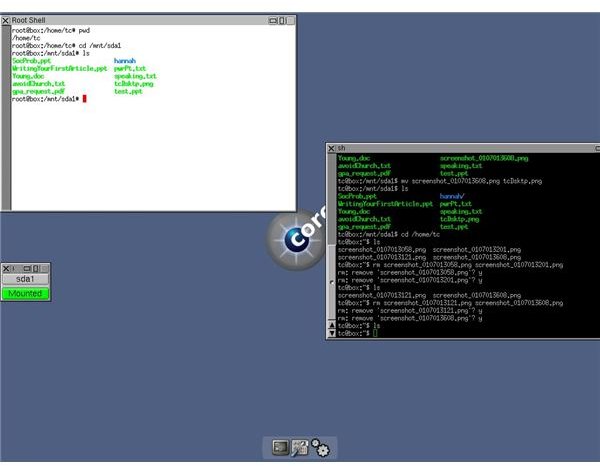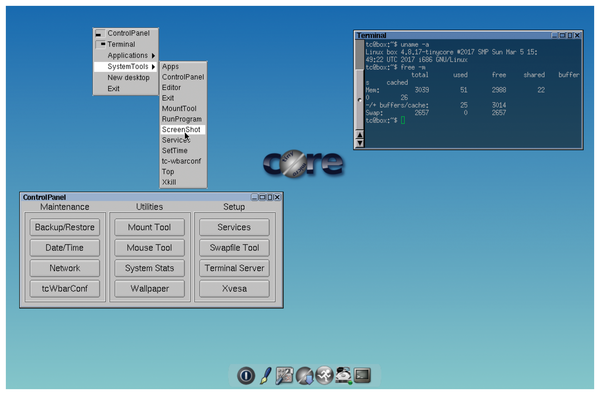
- Install Tiny Core Linux From Windows 7
- Tiny Core Linux Forum
- Install Tiny Core Linux From Windows 10
- Install Tiny Core Linux From Windows Xp
- Install Tiny Core Linux From Windows 7
- Peppermint Linux
TinyCoreLinux is handy for various tasks. I use the dCore variant because it can use many of the packages from Debian.

Qemu is especially useful because it is portable (can run off a USB flash drive) and there are versions for multiple host OS's (eg. Windows, Linux). The downside is that it's a bit slow under Windows - it needs a suitable driver to use hardware virtualisation, and there doesn't seem to be one for Windows hosts - still, it is fast enough to be useful.
This document was tested with the 25-May-2016 (v7.0?) release of dCore TinyCoreLinux, running under Qemu v2.5.0 on Windows 7 (64-bit).
Download TinyCoreLinux
Create a new directory for your VM - for this document I have used C:dCore
As at time of writing, the download directory for dCore Jessie is http://tinycorelinux.net/dCore/x86/release/dCore-jessie
Jun 26, 2011 The installer will automatically set up the Extlinux bootloader so you can start either Tinycore or Windows. Option 3: Install Tinycore in the Windows partition Download the latest multicore iso from one of the mirrors, and write it to a CD. Put the multicore CD in the drive, and restart the computer, so it runs Tinycore with grub4dos. Installing Tiny Core Linux on the virtual machine. Start the virtual machine that you created and follow these steps. Choose the installation option shown in the following screen capture: Run the Tiny Core installer by clicking TCInstall: Start the Tiny Core installation and follow these panels to install it on an empty hard drive.
If that directory does not work, start at http://tinycorelinux.net, click 'Downloads' (at top of page), then 'Other Ports (x86-64, dCore, & Raspberry Pi)', then 'Releases' in the 'dCore x86' section, then 'dCore-jessie'
- Install TinyCore. Boot from usb, choose the option with installation extension. This will copy over basic files/drivers for wifi, video resolution and nano. Go into lubuntu and edit grub: # This file provides an easy way to add custom menu entries. Simply type the. # menu entries you want to add after this comment.
- Aug 01, 2011 I have download Tiny Core Linux from the official site. I searched on the official site, but could not find a solution for my actual problem. How can I make a bootable USB stick and how can I install this Linux distribution? My Laptop configurations are RAM: 2 GB, HDD: 256 GB, DVD-RW, USB-slot available.
Download these files and put them in C:dCore:
Note that windows will probably rename the kernel from vmlinuz-jessie to vmlinuz-jessie.txt - you should rename it back to vmlinuz-jessie after download. If you've got file extensions turned off in Windows Explorer, then this will be inconvenient, and it's probably less effort to edit the launcher script to include the .txt even though the kernel is not a text file.
If you're being thorough, download the 'md5' files and use them to check the integrity of the files.
Download Qemu
I use the build of qemu found at http://lassauge.free.fr/qemu
Download Qemu-2.5.0-windows.7z and extract it into C:dCore - this will create a directory C:dCoreQemu-windows-2.5.0 containing the various qemu exe files and DLLs, etc.
Create empty disk image
We need to create a virtual hard drive to store persistent files in. Open a command prompt in C:dCore and run the following qemu-img command (you may want to specify a size different than 4G, depending on requirements):
Close the command prompt window.

Create launcher script
Create a batch file 'C:dCorego.cmd' and edit it to contain (or download):
Note: There can be no spaces at the end of the lines after ^
Things you might want/need to edit:
QEMUDIR- if you're using a different version of qemu, or have saved it somewhere else.QEMUEXE- if you're not using 64-bit windows then you probably needqemu-system-i386.exe- the name of the
kernel/initrdif you've got a newer release of dCore than Jessie, or they have different names (like an unwanted.txtextension). - change the
-kline to change the keyboard layout - you can see the valid options inC:dCoreQemu-windows-2.5.0Bioskeymaps - change the
-mline to change the amount of memory allocated to the VM. - change the window title with the
-nameline. - change the
-redirline to alter port-forwarding - the line shown above redirects port 22022 on the host machine (your Windows computer) to port 22 inside the VM. This is no use right now, but will be useful if you install SSH inside the VM. - in the
-appendline you can setup kernel command-line options.host=dcoresets the hostname of the VM.xvesa=800x600x24sets the VM display resolution.
Install Tiny Core Linux From Windows 7
Check
Just as a cross-check of the above instructions, this is what my directory contains:
First boot, and format virtual HDD
Tiny Core Linux Forum
Double-click on go.cmd and wait for it to boot (takes about 30s on my machine). Note that the boot process is a little 'messy' - you may have some messages appearing over the top of console. There are also error messages regarding the floppy drive (fd0), since it doesn't exist.
Wait for it to stop printing things, then press [Enter] a few times to get a clean prompt.
On a normal system, we'd partition the HDD and install a bootloader - this is not necessary here because we have our kernel/initrd supplied externally to the VM. We create a filesystem directly on /dev/sda instead of the more usual /dev/sda1
Run the following (ignore the harmless partition table warning):
Reboot and test
Install Tiny Core Linux From Windows 10
Click in the qemu window and run the following:
The VM will now reboot. Wait for it to start up and then have a look at the sda mountpoint:
Install Tiny Core Linux From Windows Xp
You should see that TinyCoreLinux has created the home, opt, and tce directories. If you create some SCE files (with sce-import), for example, they will be stored in /mnt/sda/tce/sce/
Similarly, your home folder files (for the default user 'tc') will be stored in /mnt/sda/home/tc/
Install Tiny Core Linux From Windows 7
References
Peppermint Linux
- Qemu comes with a help file - refer to
C:dCoreQemu-windows-2.5.0Docqemu-doc.htmlor find online qemu docs at http://wiki.qemu.org/Manual